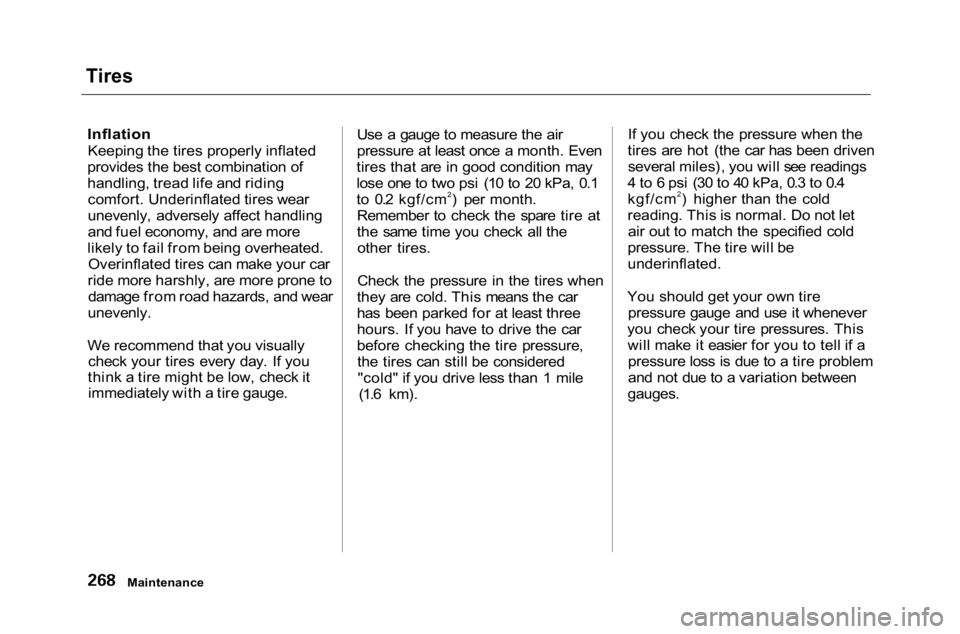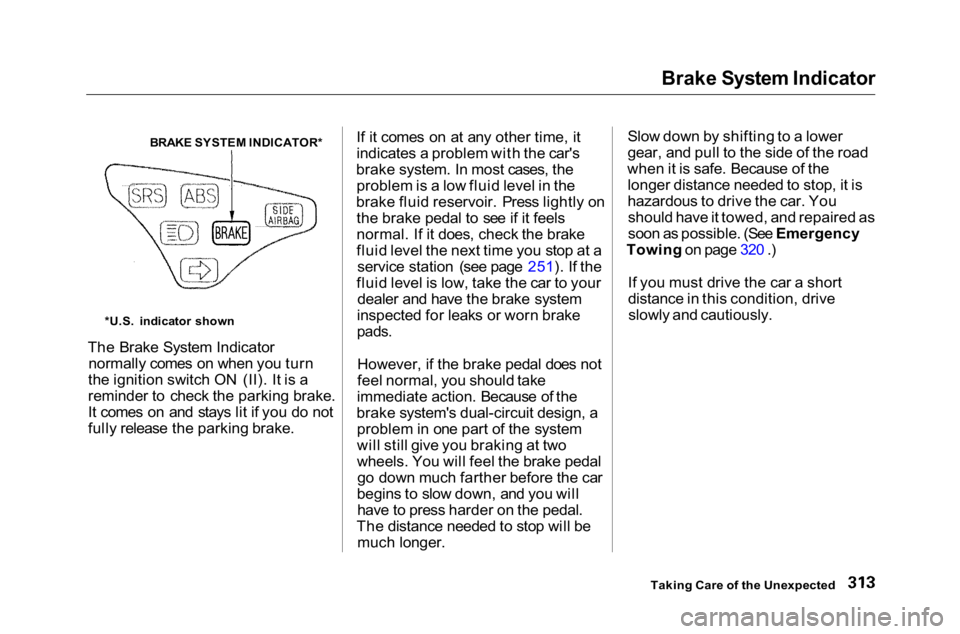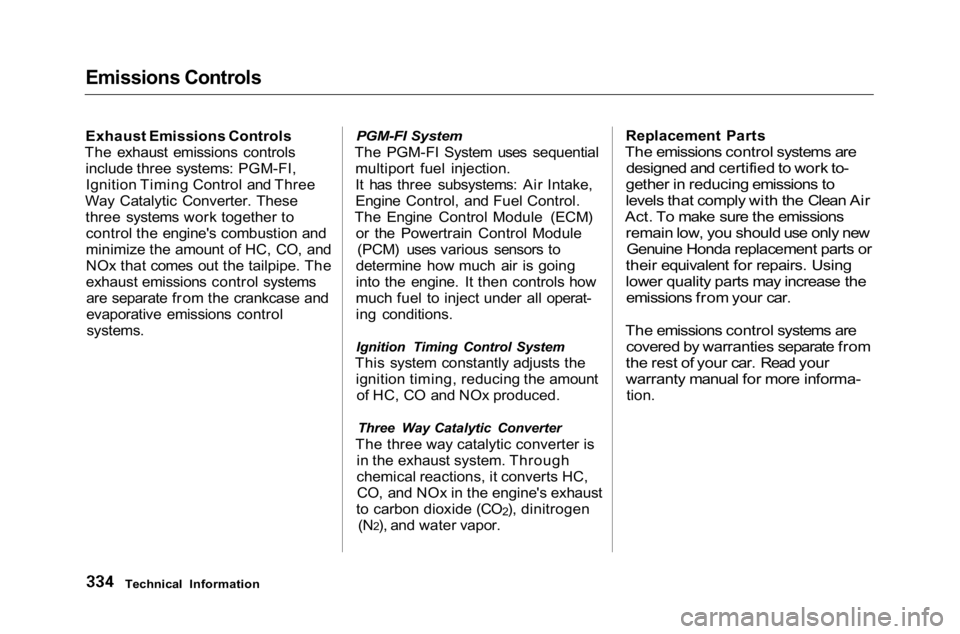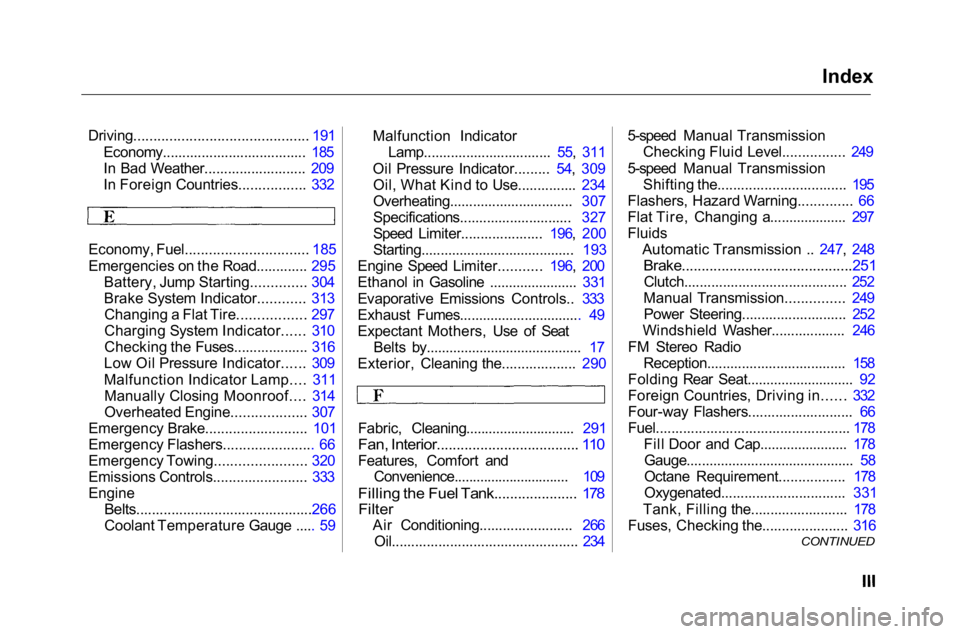air condition HONDA ACCORD SEDAN 2001 (in English) Owner's Guide
[x] Cancel search | Manufacturer: HONDA, Model Year: 2001, Model line: ACCORD SEDAN, Model: HONDA ACCORD SEDAN 2001Pages: 372, PDF Size: 6.1 MB
Page 270 of 372

Drive Belts, Timing Belt, Tires
6-cylinder models
Power steering belt:
0.51 — 0.65 in (13.0 — 16.5 mm)
If you see signs of wear or looseness,
have your dealer adjust or replace
the belts.
Timing Belt
The timing belt and balancer belt
should normally be replaced at the
intervals shown in the maintenance
schedule.
Replace these belts at 60,000 miles
(U.S.) or 100,000 km (Canada) if you
regularly drive your car in one or
more of these conditions:
In very high temperatures
(over 110° F,43°C).
In very low temperatures
(under — 20°F, — 29°C).
Tires
To safely operate your car, your tires
must be the proper type and size, in
good condition with adequate tread,
and correctly inflated. The following
pages give more detailed information
on how and when to check air
pressure, how to inspect your tires
for damage and wear, and what to do
when your tires need to be replaced.
Maintenance
Using tires that are excessively
worn or improperly inflated can
cause a crash in which you can
be seriously hurt or killed.
Follow all instructions in this
owner's manual regarding tire
inflation and maintenance.
Page 271 of 372

Tires
Inflation
Keeping the tires properly inflated
provides the best combination of
handling, tread life and riding comfort. Underinflated tires wear
unevenly, adversely affect handling
and fuel economy, and are more
likely to fail from being overheated. Overinflated tires can make your car
ride more harshly, are more prone to damage from road hazards, and wear
unevenly.
We recommend that you visually check your tires every day. If you
think a tire might be low, check it immediately with a tire gauge. Use a gauge to measure the air
pressure at least once a month. Even
tires that are in good condition may
lose one to two psi (10 to 20 kPa, 0.1
to 0.2 kgf/cm2) per month. Remember to check the spare tire at
the same time you check all theother tires.
Check the pressure in the tires when
they are cold. This means the car
has been parked for at least three
hours. If you have to drive the car
before checking the tire pressure, the tires can still be considered"cold" if you drive less than 1 mile (1.6 km). If you check the pressure when the
tires are hot (the car has been driven several miles), you will see readings
4 to 6 psi (30 to 40 kPa, 0.3 to 0.4
kgf/cm2) higher than the cold
reading. This is normal. Do not let air out to match the specified cold
pressure. The tire will be
underinflated.
You should get your own tire pressure gauge and use it whenever
you check your tire pressures. This will make it easier for you to tell if apressure loss is due to a tire problem
and not due to a variation between
gauges.
Maintenance
Page 273 of 372

Tires
Inspection
Every time you check inflation, youshould also examine the tires for
damage, foreign objects, and wear.
You should look for: Bumps or bulges in the tread orside of the tire. Replace the tire if
you find either of these conditions.
Cuts, splits, or cracks in the side
of the tire. Replace the tire if you
can see fabric or cord.
Excessive tread wear. INDICATOR LOCATION MARKS
Your car's tires have wear indicators molded into the tread. When the
tread wears down to that point, you
will see a 1/2 inch (12.7 mm) wide band running across the tread. This shows there is less than 1/16 inch (1.6 mm) of tread left on the tire. A
tire that is this worn gives very little
traction on wet roads. You should replace the tire if you can see the
tread wear indicator in three or more
places around the tire. Maintenance
In addition to proper inflation,
correct wheel alignment helps todecrease tire wear. If you find a tire
is worn unevenly, have your dealer
check the wheel alignment.
The tires were properly balanced by the factory. They may need to berebalanced at some time before theyare worn out. Have your dealer
check the tires if you feel a consis-
tent vibration while driving. A tire should always be rebalanced if it is
removed from the wheel for repair.
Maintenance TREAD WEAR INDICATORS
Page 316 of 372

Brake System Indicator
BRAKE SYSTEM INDICATOR*
The Brake System Indicator normally comes on when you turn
the ignition switch ON (II). It is a
reminder to check the parking brake.
It comes on and stays lit if you do not
fully release the parking brake. If it comes on at any other time, it
indicates a problem with the car's
brake system. In most cases, the problem is a low fluid level in the
brake fluid reservoir. Press lightly on the brake pedal to see if it feels
normal. If it does, check the brake
fluid level the next time you stop at a service station (see page 251). If the
fluid level is low, take the car to your dealer and have the brake system
inspected for leaks or worn brake
pads.
However, if the brake pedal does not
feel normal, you should take
immediate action. Because of the
brake system's dual-circuit design, a problem in one part of the system
will still give you braking at two
wheels. You will feel the brake pedalgo down much farther before the car
begins to slow down, and you will have to press harder on the pedal.
The distance needed to stop will be much longer. Slow down by shifting to a lower
gear, and pull to the side of the road
when it is safe. Because of the longer distance needed to stop, it is
hazardous to drive the car. Youshould have it towed, and repaired as
soon as possible. (See Emergency
Towing on page 320 .)
If you must drive the car a short
distance in this condition, driveslowly and cautiously.
Taking Care of the Unexpected
*U.S. indicator shown
Page 336 of 372

Emissions Controls
The burning of gasoline in your car's engine produces several byproducts.
Some of these are carbon monoxide (CO), oxides of nitrogen (NOx) and
hydrocarbons (HC). Gasoline evaporating from the tank also
produces hydrocarbons. Controlling
the production of NOx, CO, and HC is important to the environment.
Under certain conditions of sunlightand climate, NOx and HC react to
form photochemical "smog." Carbon monoxide does not contribute tosmog creation, but it is a poisonous
gas.
The Clean Air Act
The United States Clean Air Act*
sets standards for automobile
emissions. It also requires that
automobile manufacturers explain to
owners how their emissions controls
work and what to do to maintain
them. This section summarizes how
the emissions controls work.
Scheduled maintenance is on page
224.
* In Canada, Honda vehicles comply
with the Canadian Motor Vehicle
Safety Standards (CMVSS) for
Emissions valid at the time they are
manufactured.
Crankcase Emissions Control
System
Your car has a Positive Crankcase
Ventilation System. This keeps gasses that build up in the engine'scrankcase from going into the
atmosphere. The Positive Crankcase
Ventilation valve routes them from the crankcase back to the intake
manifold. They are then drawn into
the engine and burned.
Evaporative Emissions Control
System
As gasoline evaporates in the fuel tank, an evaporative emissions
control canister filled with charcoaladsorbs the vapor. It is stored in this
canister while the engine is off. After
the engine is started and warmed up,
the vapor is drawn into the engine and burned during driving.
Onboard Refueling Vapor
Recovery
The Onboard Refueling Vapor Recovery (ORVR) system captures
the fuel vapors during refueling. The
vapors are adsorbed in a canister filled with activated carbon. While driving, the fuel vapors are drawn
into the engine and burned off.
Technical Information
Page 337 of 372

Emissions Controls
Exhaust Emissions Controls
The exhaust emissions controls include three systems: PGM-FI,Ignition Timing Control and Three
Way Catalytic Converter. These three systems work together tocontrol the engine's combustion and
minimize the amount of HC, CO, and
NOx that comes out the tailpipe. The
exhaust emissions control systemsare separate from the crankcase and
evaporative emissions control
systems.
PGM-FI System
The PGM-FI System uses sequential multiport fuel injection.
It has three subsystems: Air Intake,
Engine Control, and Fuel Control.
The Engine Control Module (ECM) or the Powertrain Control Module (PCM) uses various sensors to
determine how much air is going
into the engine. It then controls how
much fuel to inject under all operat-
ing conditions.
Ignition Timing Control System
This system constantly adjusts the ignition timing, reducing the amountof HC, CO and NOx produced.
Three Way Catalytic Converter
The three way catalytic converter is in the exhaust system. Through
chemical reactions, it converts HC,CO, and NOx in the engine's exhaust
to carbon dioxide (CO 2), dinitrogen
(N2), and water vapor. Replacement Parts
The emissions control systems are
designed and certified to work to-
gether in reducing emissions to
levels that comply with the Clean Air
Act. To make sure the emissions
remain low, you should use only newGenuine Honda replacement parts or
their equivalent for repairs. Using
lower quality parts may increase the emissions from your car.
The emissions control systems are
covered by warranties separate from
the rest of your car. Read your
warranty manual for more informa-
tion.
Technical Information
Page 350 of 372

Index
Accessories and Modifications.... 186 Accessories................................. 186Additional Safety Precaution.... 187 Modifications............................. 187
ACCESSORY (Ignition Key Position)........................................ 74
Accessory Power Socket.............. 106
Additives, Engine Oil..................... 234
Airbag (SRS) ...................................... 9
Air Cleaner Element...................... 253
Air Conditioning............................. 110
Maintenance............................... 265
Usage.......................................... 110
Air Conditioning Filter.................. 266
Air Pressure, Tires........................ 268
Alcohol in Gasoline........................ 331
Antifreeze....................................... 239
Anti-lock Brakes (ABS)
Description................................. 204
Indicator............................... 55, 205
Operation.................................... 204
Anti-theft Steering Column Lock.. 73
Appearance Care........................... 287
Audio System................ 125, 137, 153
Automatic Speed Control................
68
Automatic Transmission............... 196
Capacity, Fluid........................... 326
Checking Fluid Level....... 247, 249
Shifting........................................ 196
Shift Lever Position Indicator.. 197
Shift Lever Positions................. 197
Shift Lock Release..................... 200
Battery Charging System Light...... 54, 310
Jump Starting............................. 304
Maintenance............................... 260
Specifications............................. 329
Before Driving............................... 177
Belts, Seat........................................... 8
Beverage Holder............................ 104
Body Repair.................................... 296
Brakes Anti-lock System (ABS)............ 204Break-in, New Linings .............. 178
Bulb Replacement..................... 281
Fluid............................................ 251
Parking........................................ 101
System Indicator.......................... 55
Wear Indicators......................... 203
Braking System.............................. 203
Break-in, New Car......................... 178 Brightness Control, Instruments... 63
Brights, Headlights......................... 62
Bulb Replacement Back-up Lights........................... 281
Brake Lights............................... 281Ceiling Light............................... 282
Courtesy Light........................... 283
Front Parking Lights................. 278
Front Side Marker Lights......... 277
Headlights.................................. 276
High-mount Brake Light.......... 281
License Plate Lights.................. 281
Specifications............................. 327
Spotlight...................................... 283
Trunk Light................................ 284
Turn Signal Lights..................... 277
Bulbs, Halogen............................... 276
CONTINUED
Page 352 of 372

Index
Driving............................................ 191 Economy..................................... 185
In Bad Weather.......................... 209
In Foreign Countries................. 332
Economy, Fuel............................... 185
Emergencies on the Road............. 295 Battery, Jump Starting.............. 304
Brake System Indicator............ 313Changing a Flat Tire................. 297
Charging System Indicator...... 310
Checking the Fuses................... 316
Low Oil Pressure Indicator...... 309
Malfunction Indicator Lamp.... 311 Manually Closing Moonroof.... 314
Overheated Engine................... 307
Emergency Brake.......................... 101
Emergency Flashers....................... 66
Emergency Towing....................... 320
Emissions Controls........................ 333
Engine
Belts.............................................266
Coolant Temperature Gauge ..... 59 Malfunction Indicator
Lamp................................. 55, 311
Oil Pressure Indicator......... 54, 309 Oil, What Kind to Use............... 234
Overheating................................ 307
Specifications............................. 327
Speed Limiter..................... 196, 200
Starting........................................ 193
Engine Speed Limiter........... 196, 200
Ethanol in Gasoline ....................... 331
Evaporative Emissions Controls.. 333
Exhaust Fumes................................ 49
Expectant Mothers, Use of Seat Belts by......................................... 17
Exterior, Cleaning the................... 290
Fabric, Cleaning............................. 291
Fan, Interior.................................... 110
Features, Comfort and Convenience............................... 109
Filling the Fuel Tank..................... 178
Filter
Air Conditioning........................ 266
Oil................................................ 234 5-speed Manual Transmission
Checking Fluid Level................ 249
5-speed Manual Transmission Shifting the................................. 195
Flashers, Hazard Warning.............. 66
Flat Tire, Changing a.................... 297
Fluids Automatic Transmission .. 247, 248
Brake...........................................251
Clutch.......................................... 252
Manual Transmission............... 249 Power Steering........................... 252
Windshield Washer................... 246
FM Stereo Radio Reception.................................... 158
Folding Rear Seat............................ 92
Foreign Countries, Driving in...... 332
Four-way Flashers........................... 66
Fuel.................................................. 178 Fill Door and Cap....................... 178Gauge............................................ 58
Octane Requirement................. 178
Oxygenated................................ 331
Tank, Filling the......................... 178
Fuses, Checking the...................... 316
CONTINUED